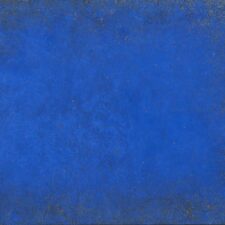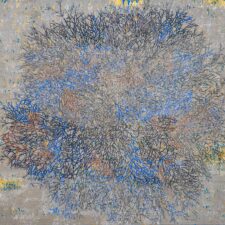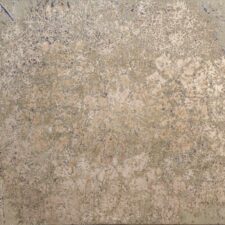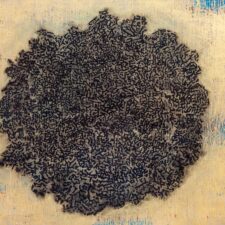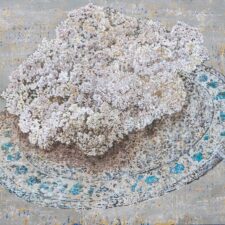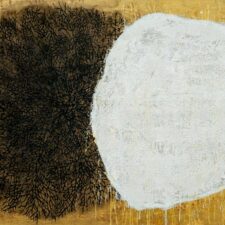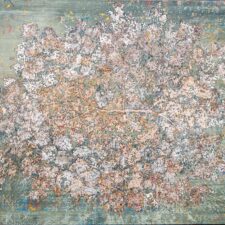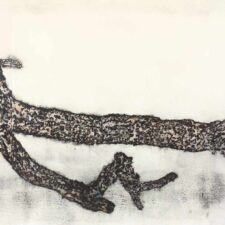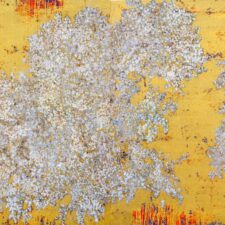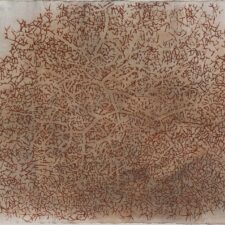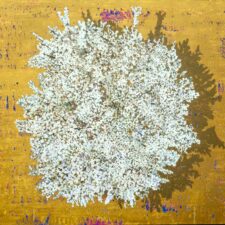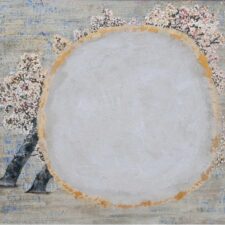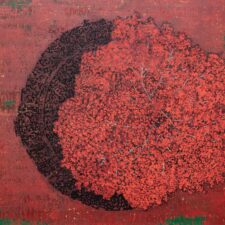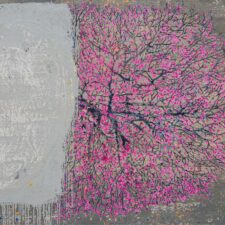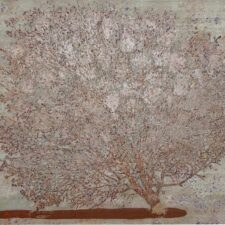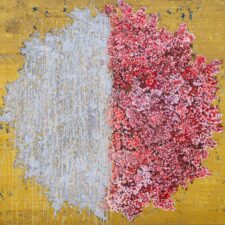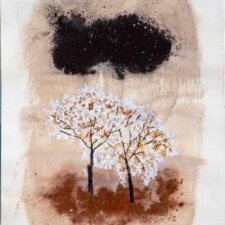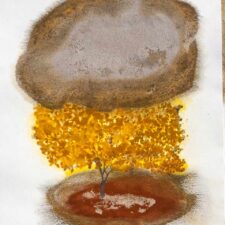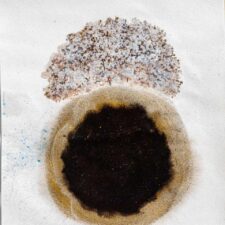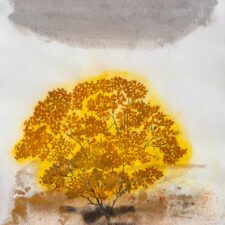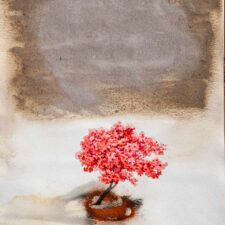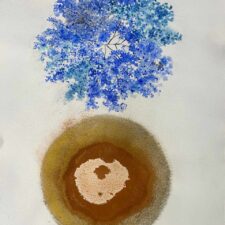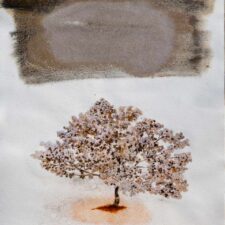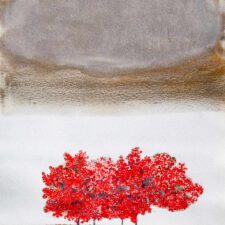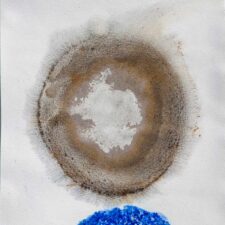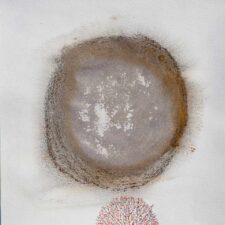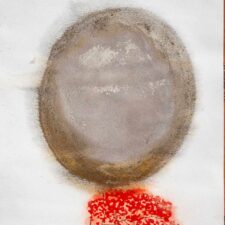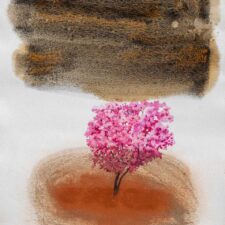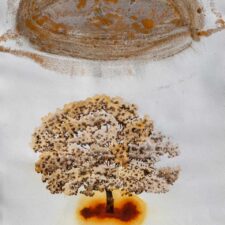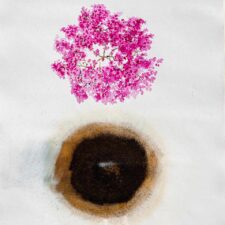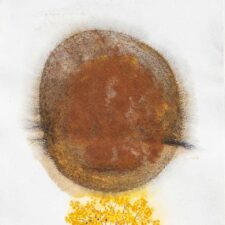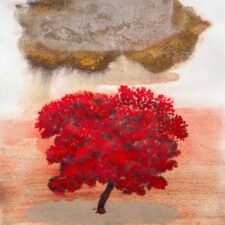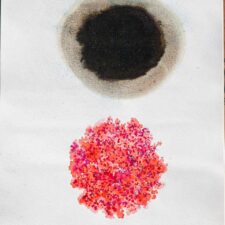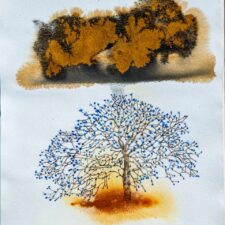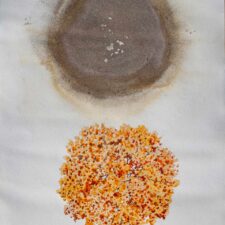Floating Verses
We connect to allegories of our society, culture, and religion and attribute meaning to them because of how we grow up with them, what role they play in our childhood, and how they make space for new experiences only to reappear, transformed, in our adult lives. They are deeply anchored in our psyche, and we may embrace or reject them for that very reason. The Indian artist G.R. Iranna, who has been getting international attention since his participation in the 2019 Venice Biennale, has created a new body of work for his fifth exhibition at Aicon Contemporary in New York, where he comes full circle with an element that he is intimately familiar with from his childhood growing up in a farmer’s family: the tree. There is a tree in some shape or form in each of the new paintings in Under The Planet. In rich and multilayered explorations of composition, color, and material, these trees variably dissolve into a sky of cobalt blue, explode in a thousand pink blossoms, spread out in gold leaves, and become intricate labyrinths. Ghostlike clouds hover over them and shadows double as their auras and alter egos.
Perhaps a culmination of the past 25 years of his critical inquiry into social, political, moral, and spiritual issues, Iranna has created an exquisite and joyous exhibition of large-scale paintings and a series of delicate, luminous works on paper. Since his first exhibition at Aicon Contemporary in 2006, his preoccupation with the human existence has deepened while moving away from the representation of the figure that inevitably leads to literal interpretation. In the past, Iranna would often depict humans, both in paintings and life-size sculptures, that seemed stripped of any personality and looked disoriented—blindfolded and huddled in masses, mute conformists to religion and consumerism, soldiers in meaningless war machines, and prisoners of social constructs.
The messages were stark and unambiguous, as in Make Sure you are Breathing, 2006, where a naked, life-size male figure in fiberglass has a Jute bag pulled over his head with an inscription in Arabic that reads, “Gift from America.” Some of the paintings, such as Tempered Temple, 2009, evoke the surrealist Rene Magritte who depicted humans in dreamlike states of isolation and frustration, caught in their social roles and mores. Iranna’s installation at the Indian Pavilion for the 2019 Venice Biennale, which coincided with the 150th anniversary of Mahatma Gandhi, was more conceptual. Naavu, which means “we together,” celebrates the power of people who coalesce around a cause. Consisting of a sea of padukas or wooden slippers covering entire walls, it conjured up Gandhi’s spirit who enticed millions of people to walk thousands of kilometers in his movement for India’s independence.
Iranna’s trajectory parallels that of other artists who have transcended their geographical and social environments to come into their own. His move to big urban centers like Delhi and London to become an artist, far away from his village and farming background in Karnataka, was a rebellious act in a society where the concept of an artist does not exist. This reminds us of Auguste Rodin, who was from a working-class background and who was for a long time not accepted in Parisian society. In contrast to other artists of his era who favored idealized portrayals of beautiful subjects, Rodin was known for the physicality of emotions in his large-size sculptures, and often portrayed his subjects as flawed, wracked by guilt, anger, despair and other dark emotions, not unlike Iranna’s early work.
The radical and intriguing shift away from the literal depiction of the human as a vulnerable, lonely figure that is easily oppressed and abused to a similarly obsessive focus on one of the most life-spending elements of nature—the tree—may be a sign of the artist overcoming a certain existential angst. Iranna achieves this through abstraction. It is historically not unusual for artists to move from representation to abstraction—many cubists, abstract expressionists, and pop artists were figurative painters in their early days, from Pablo Picasso to Willem de Kooning, to Jackson Pollock, and Roy Lichtenstein. Abstraction has allowed artists to express ideas more freely. In that vein, Iranna continues to critique what humans are doing to this world, but he’s taking a step back and lets nature tell the story, allowing the viewer a certain freedom, too. By letting materials and forms take hold of the canvas, he allows for specific narratives to be deconstructed, thus releasing energy, and inviting us to take a closer look at the subtle nuances of nature’s cycle, which we are part of.
Iranna’s return to early childhood memories is thus not simply nostalgic but a philosophical and spiritual extension of his earlier work. A wonderful example of where Iranna may evoke his father’s sugarcane, grapes, and mango orchards through abstract forms and color compositions is Tree with Dust Shadow, 2022. Two halves of a tree, painted in various hues of the primary colors red and white, are floating in a mustard yellow background, reminding of Mark Rothko’s No. 13 (White, Red on Yellow), one of the artist’s unusually bright and joyous works.
Indeed, in Under The Planet, Iranna skillfully channels his observations of nature’s transformations, both monumental and subtle, onto the canvas: the cycle of growth and decay, the convergence of energy and matter, the explosions of color and form. All of this is palpable in The Fragrance Beneath, 2022, which shows a tree and its shadow, though it is not clear which one is which. Dark red, saturated terracotta powder and shiny silver foil depict the two distinct bodies of the tree, with the middle part overlapping. Iranna often lets natural oxidation take place over months on silver foil to get the hue of brown he is looking for, then fixes it with varnish. Other areas of the painting are mixed with grey ash. A similar process is taking place in The Poem Without Words, 2021, made of acrylic and silver foil, depicting a tree leaning to the left, leaving a dark, bloody shadow underneath, as if life had seeped out of the tree.
The relief, surface, and texture deriving from the various layers of material in these works resemble the weathered skin of an older person and add a level of mystery that comes with mature age—we learn later in life that things are not black and white, what shines is not always gold, and gold is not necessarily more precious than brick. The symbolism of these altered materials are not lost, either. Bricks are the baseline for structures of religious places where people meditate and worship. Ash has similarly spiritual meanings for Iranna, who grew up with it being put on his forehead. These processes, just like human existence, often don’t happen without violence. Ash derives not only from trees destroyed by fires but when a Hindu dies, they are burned. The new substance no longer belongs to a particular person but becomes formless and holy, and should reenter the cycle of life. Ash was a signifier of belief. Yet, ash was also an equalizer, the last physical manifestation of man and tree.
Another exploration of the withering of life takes place in Confuse Shadow, 2022. Painted in dampened tones of grey and washed-out light blue, the tree’s shadow is a worn carpet, which is a recurrent theme in Iranna’s work; its wear and tear a sign of aging—not unlike the tarpaulin that Iranna is using instead of canvas.
Various important Germanic artists with a unique command of process, form, and natural materials to reference myth and symbolism, and life and death, come to mind. Anselm Kiefer uses lead, glass shards, dried flowers, and strands of hay to create microcosms of collective memory that reference cultural, literary, and philosophical allusions. Just as Kiefer creates earthy colors through these materials, mulling over post-war identity, grappling with national and racial mythology, so too does Iranna, deliberately using materials, such as ash, with strong religious symbolism, pulling it into secular space, thereby expanding it, in a possible rebuke to the shrinking of secular space in contemporary India, where religion and nationalism has been encroaching upon it.
Wolfgang Laib, who hails from a small village like Iranna and often works in South India, creates vibrant, large-scale installations with perishable organic materials, such as pollen, milk, wood, and rice as well as durable ones that include granite, marble, and brass, to connect the past and present, the ephemeral and the eternal. Some of Iranna’s meticulous application of patterns and the use of precious metals can be compared to the work of Austrian artist Gustav Klimt. Floating Flowers, 2022, is an arresting 11-foot wide diptych of intricately detailed white blossoms set against a background of gold leaf with a hint of fiery red; and Pink Blossom, 2022, captures the explosion of thousands of blossoms in fabulous hues of pink in such a way that the motive recedes into the background and the process comes to the fore.
Iranna’s veneration and celebration of nature is palpable throughout this body of work—yet there are some darker, warning undertones. In Frozen Cloud on Blossom, 2021, for example, two trees are leaning sharply to the right as if windblown, obscured by a large, white cloud with an orange outer ring, which could also be a tree trunk. The “frozen cloud” is hitting the delicate spring blossoms in full bloom. Some of the signs of our climate crisis are increased occurrences of extreme weather, such as hailstorms during heat waves with large chunks of ice destroying the fruit blossoms and hence the crop. The painting is a delicate yet powerful reminder of the destruction of agricultural communities—something Iranna probably witnessed first-hand—and the ensuing climate refugee crisis.
This is a time when more diverse voices are finally invited into the art world. Iranna is an important contributor to that global dialogue. He needs to be seen as part of a growing cohort of artists who are deeply concerned about our impact on the planet. Various stages of life have prepared him for this: he grew up as a reserved child who used to draw to communicate; followed by the “Gurukul”—a traditional Indian school, literally “the home of the guru, where pupils live with their guru und the teaching methods focus on the value of the human being and living experiences rather than the book; as well as influences from the Bhakti movement, which celebrates self-realization: God within us and our body is a temple that we have to take care of.
Iranna’s art comes from within. In a time when our relationships with each other and this earth are fractured, his art can help us to restore and reconcile these relationships. Trees represent resilience, wisdom, and growth. Iranna is asking us to be that tree.
by Corinne Erni

